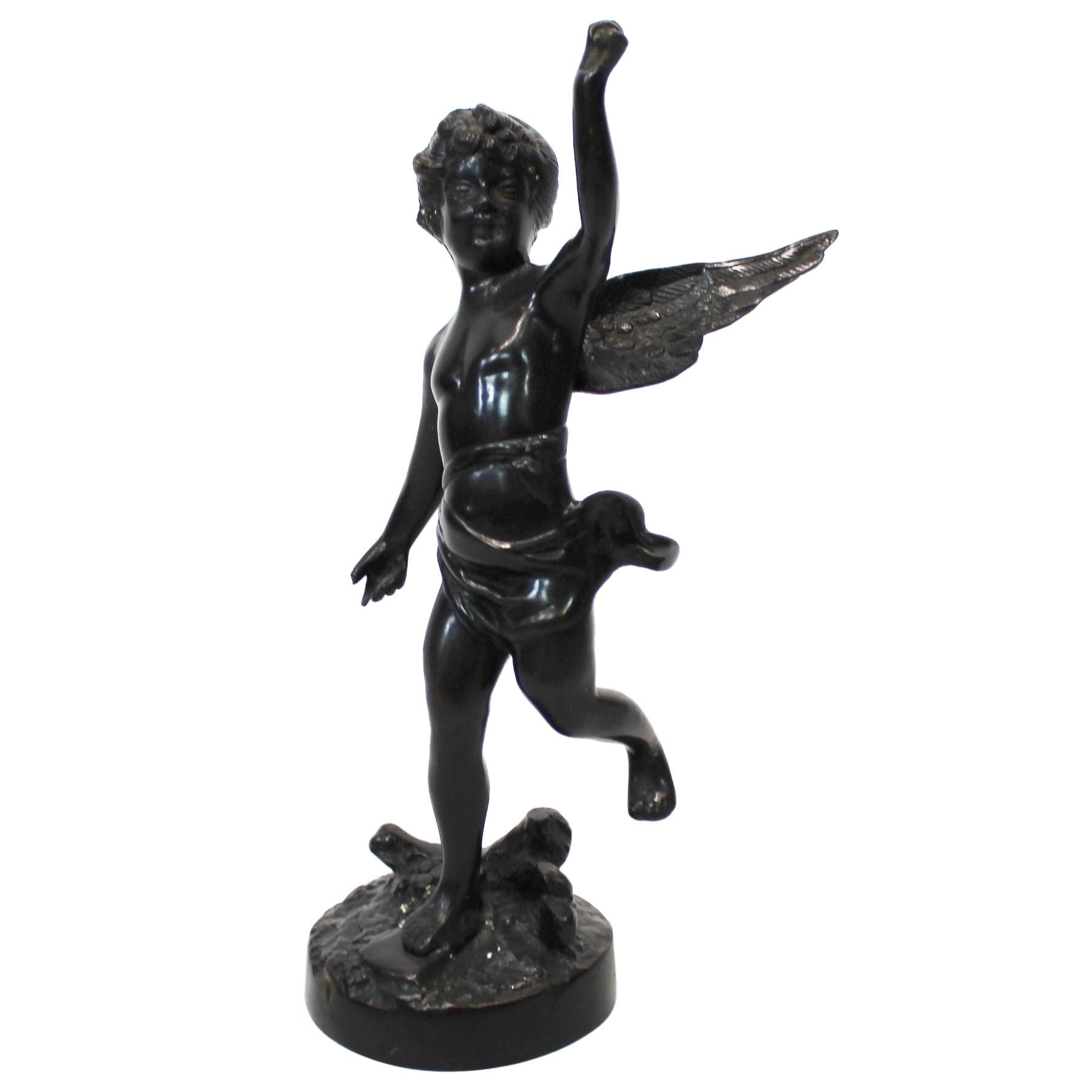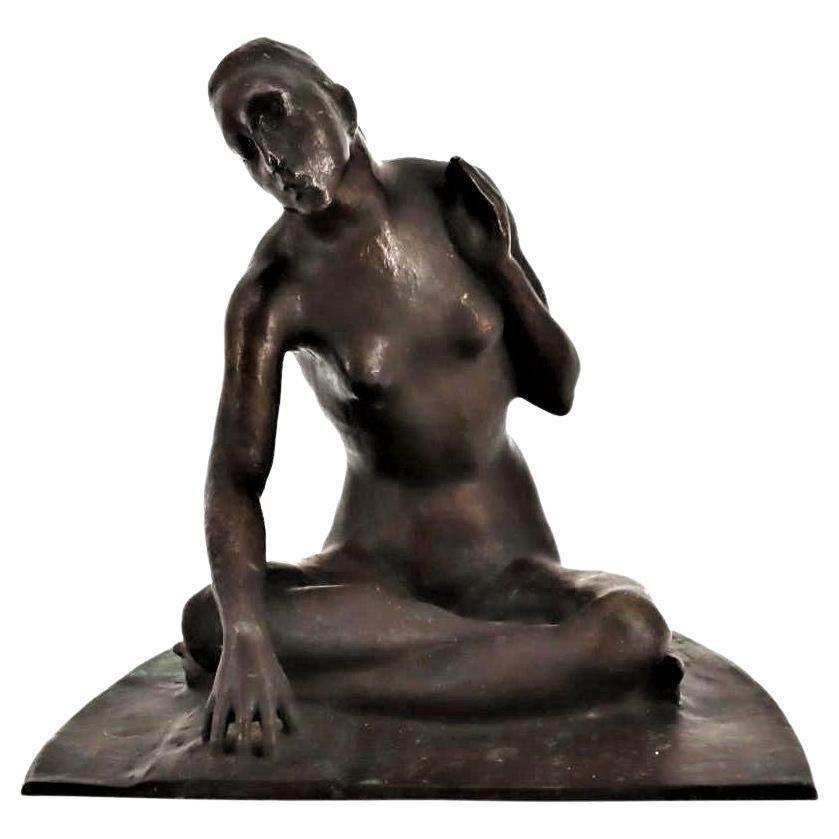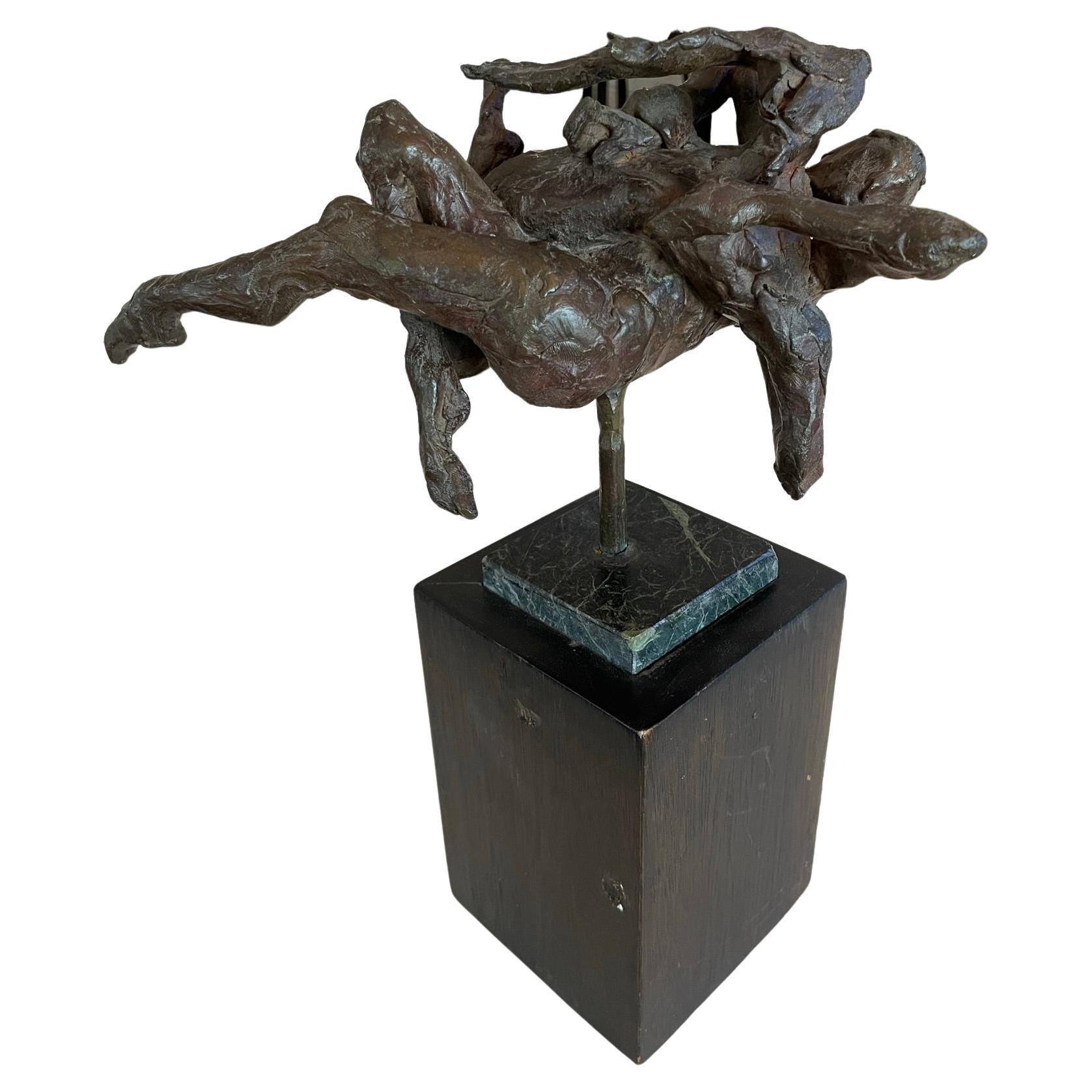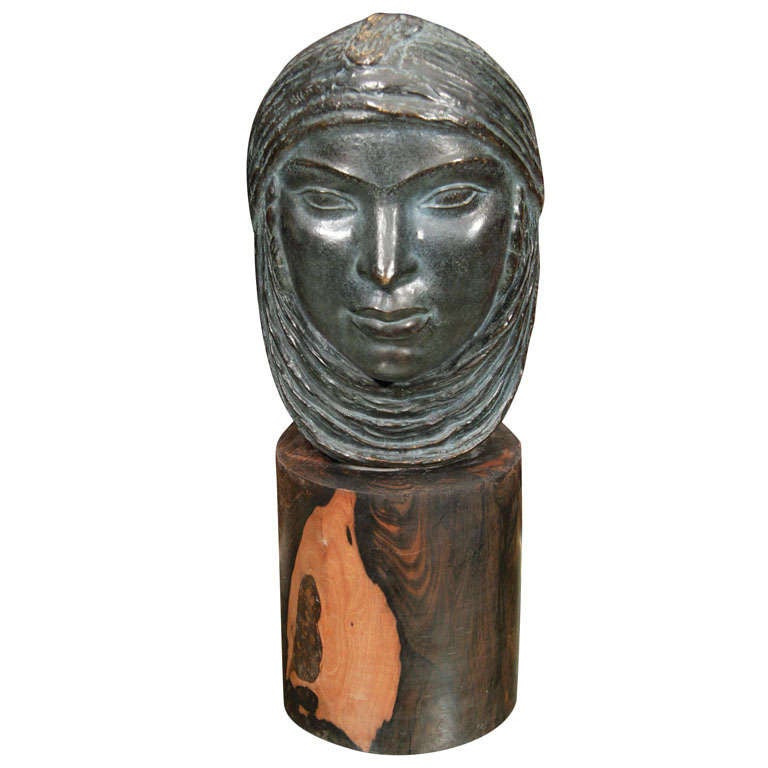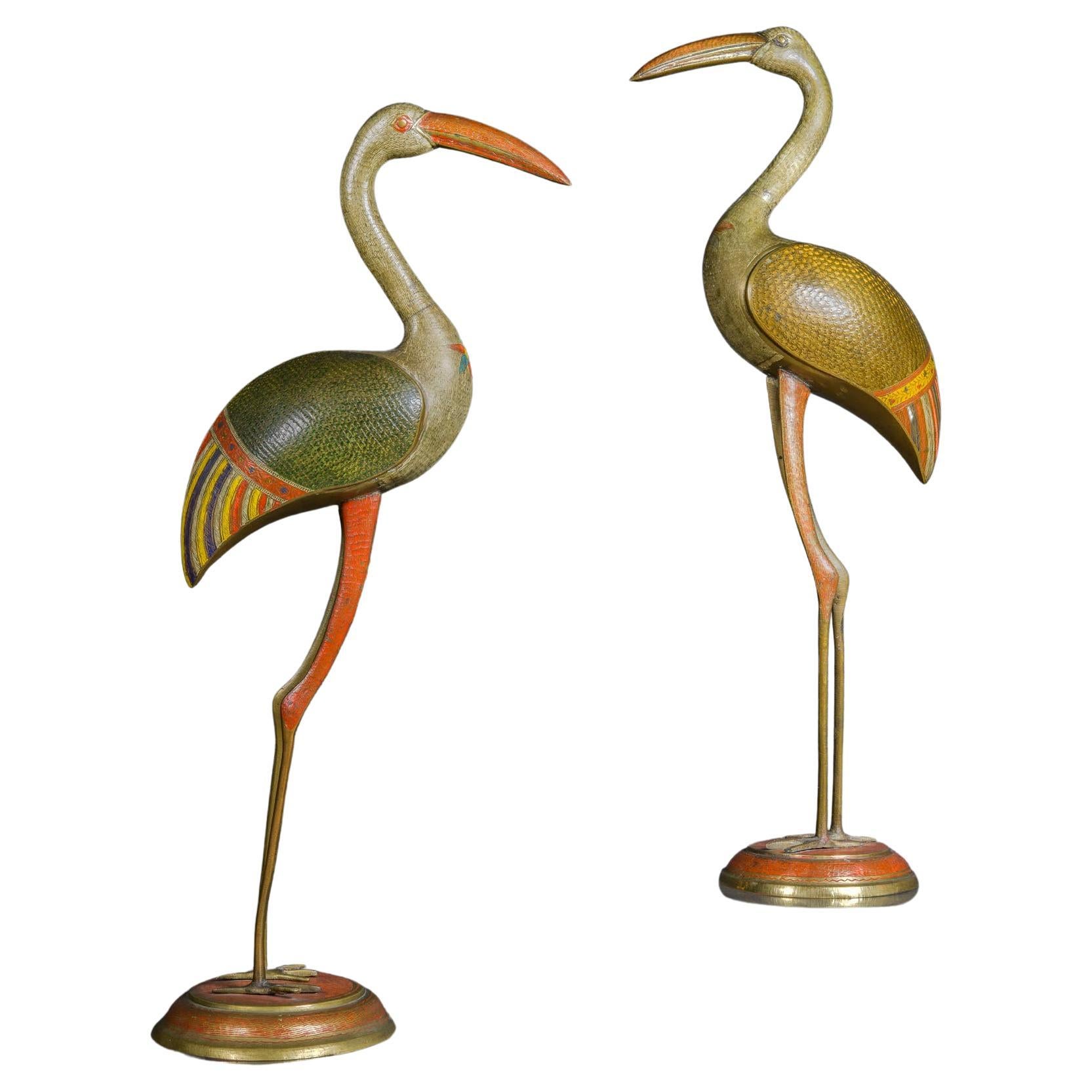Items Similar to Marina Núñez del Prado, Head, Patinated Bronze Sculpture, 1930s
Want more images or videos?
Request additional images or videos from the seller
Marina Núñez del Prado, Head, Patinated Bronze Sculpture, 1930s
About the Item
Marina Núñez del Prado (1910-1995) was a celebrated Bolivian sculptor and one of the most respected sculptors from Latin America. Her work is highly sensuous, with rolling curves. She carved from native Bolivian woods, as well as black granite, alabaster, basalt and white onyx. Perhaps one of her most famous works is "White Venus" (1960), a stylized female body in white onyx. Another celebrated work is "Mother and Child," sculpted in white onyx. Indigenous Bolivian cultures inspired much of her work.
Marina Núñez Del Prado was born in La Paz, Bolivia on October 17, 1910. Del Prado first discovered her love of art in her youth while studying sculptural modeling techniques in La Paz. Her passion for sculpture was inspired by the work of Michelangelo, and she went on to study fine art at the Academy of Fine Arts in La Paz, graduating in 1930. She continued on at her alma mater as an instructor of artistic anatomy and sculpture. She became the first woman to achieve a position as the chair of the Academy.
While she was working at the Academy of Fine Arts, La Paz, Del Prado began exhibiting locally. She was very artistically active, and collaborated with various artists, such as Cecilio Guzmán de Rojas, a Bolivian painter who led the indigenous art movement at that time. Similarly Del Prado primarily focused her work on the rights of indigenous peoples and indigenismo, a political ideology centering the relationship of the indigenous population with the government.
Del Prado left her job at the university and her home city of La Paz to travel in 1938. She spent the next several years traveling through Peru, Uruguay, and Argentina. She then traveled to other countries outside of South America, including Egypt, parts of Europe, and the United States, where she studied for 8 years in New York on a fellowship awarded by the America Association of University Women.
While in New York, Del Prado won a Gold Medal for her exhibition “Miners in Rebellion.” This work was centered around the workers of the Bolivian region of Potosi. Shortly after this, in 1948, Del Prado moved back to La Paz, where she continued to make work inspired by the indigenous peoples of South America, as well as the landscape and culture of her homeland. She later moved to Peru in 1972, where she lived with her husband, Jorge Falcón, a writer native to Peru. With her four siblings, Del Prado donated the Casa Museo Marina Nuñez del Prado to the people of Bolivia in memory of her parents. The museum houses over a thousand works of art, mostly done by Del Prado and some by her sister, Nilda. Del Prado passed away in Lima, Peru in 1995.
In 1938 she left her post and traveled through Bolivia, Peru, Argentina, Uruguay, the United States, Europe, and Egypt. From 1940-1948, she worked and organized exhibitions of her work in the United States while on a scholarship. In 1946 "Miners in Revolt," inspired by the miners in Bolivia's Potosí Department, won a gold medal in a New York exhibition. In 1948 she returned to Bolivia, finally settling down in La Paz in 1958. By 1972 she moved to Peru where she lived with her husband, a Peruvian writer.
Along her successful career she met outstanding artists such as Pablo Picasso, Constantin Brâncu?i, poets Gabriela Mistral, Alfonsina Storni and Juana de Ibarbourou. She was also a friend of the Bolivian writer Franz Tamayo. Her work has been the subject of international and national critique. Botelho Gozalvez (1961) argues that her work is marked by two main characteristics: grace and strength. The strength is seen through her Andean landscapes and her grace is recognizable in the harmonious geometry of her works. Botelho claims that Nunez del Prado has a “genius loci” and distinguishes four periods in her work. The first period is characterized by the musical thematic of her work. The second period is characterized by the use of bidimensional sculpture and a social tematic. The third period is characterized by the tridimensional stone sculpture. It is also known as the ‘maternal’ period because of her aymara Madonnas and other depictions of indigenous women. Finally, the fourth period is the neo-abstract which has been influenced by Picasso, Archipenko and Milles. In similar fashion Hector Herazo Rojas (1962) argues that her works is characterized by strength, grace and monumentality He also points out that her works revolve around the thematic of race, myth and tradition. Her sculptures of indigenous motherly figures and mythic animals can attest to this. Pedro Querejazu (1996) coincides with Herazo Rojas on her race thematic and suggest that her sculptures originated within the movement of ‘native’ realism. According to him, her later her work adopted a modern and international expression which achieved a final stage immersed in the abstractism. This later work focused on the female figure and creatures of the Andes. On this later stage she worked with Amazonian tropical woods, bronze, and stones such as granite, andesite, basalt, onyx and marble. Other critics like Eduardo Mendoza Varela (1961), who reviewed her sculptures exhibition shown in the Luis Angel Arango library at the bank of the Republic of Colombia in Bogota Colombia, argues that her work is ‘miraculous’ and ‘mysterious’. His critique employs poetic metaphors to emphasize her skills and mastery of the materials in her sculptures. He considers the abstracted and reduced forms as possessing the ability to go beyond just physical representation but capture the spirit of the artist herself.
The critic Guillermo Nino de Guzman also refers to her work as ‘genius’ and a constant force of creative energy in regards to her series “Mujeres al Viento”(Página 7, 2014). Finally, her work has inspired poetry verses. The Spanish poet Rafael Alberti has dedicated an homage to her work.
Núñez Del Prado Museum
In the 1970s Marina Núñez del Prado established her residence and art studio in what would become the Museum Hose, located in 300 Ántero Aspillaga Street, right at the center of the El Olivar Forest. This neocolonial style building was conceived in 1926 by the engineer Luis Alayza and Paz Soldán and raised by the master builder Enrique Rodrigo, being one of the first buildings in the area. It became the first house in the whole of El Olivar to be declared National Cultural Heritage and in 1984 the house-museum of the Núñez del Prado Foundation was officially inaugurated in La Paz in honor of Marina Núñez del Prado's parents.
The House Museum governed by the Foundation Nuñez Del Prado, is a Private Museum that enriches the Bolivian heritage. For decades it was a home and studio to Marina Nunez del Prado, and now it has become the Casa Museo and a treasured place of history and talent to those of Bolivia. The museum contains 1,014 works by del Prado, which constitute the greater repository of her work including sculptures, drawings and sketches by Marina, thus making it the largest existing collection of her works. But within the museum you will not only find the work of Marina, but also that of her sister Nilda, who was a great goldsmith and painter. The museum is filled with their family environment, works of her father, and the collections of Bolivian Silver, Colonial Art, Contemporary Painting, and Handicrafts.
The house is surrounded by a garden of sculptures that had changing results affected by the urban modifications of its surroundings. It is composed of two levels being the first one of adobe and the second one of quincha brava. On the first floor there is a small central courtyard with a fused iron fountain. Its façade is colorful and on the right hand side, it reproduces, on a smaller scale, the front of the famous Palace of the Admiral of the city of Cusco. The workshop of the sculptor Marina Núñez, located on the second level, has been considered as the heart of the house and the intervention revolves around it.
For a large period of time the situation of the home museum of Marina Nunez del Prado was one of complication. At the time the museum had been closed and forgotten for almost 10 years due to lack of management and support. The closing was due to a break in its infrastructure during the initial construction of the American Tunnel and had remained closed to the public while many people claim the national or municipal government never took care of the situation. There exist many personal accounts of neighbors who had watched the museum remain neglected for years and described its importance to their community and art history. They speak highly of the museum and the work included as well as speak fondly of del Prado as an artist. In 2012 they published a note that restoration of the house would begin and that work was being done to solve the many architectural issues. It was reopened in April 2015 by the San Isidro District Council and the curatorial work made for the selection of the pieces being shown was made by Gustavo Buntinx.
- Creator:Marina Núñez del Prado (Sculptor)
- Dimensions:Height: 15 in (38.1 cm)Width: 9 in (22.86 cm)Depth: 11 in (27.94 cm)
- Style:Art Deco (Of the Period)
- Materials and Techniques:Bronze,Patinated
- Place of Origin:Bolivia
- Period:
- Date of Manufacture:1930s
- Condition:Wear consistent with age and use. Original wood base: 7.5 x 6 x 6 inches. We make our best effort to provide a fair and descriptive condition report. Please examine the photos attentively. Send us a message to request more details or discuss price.
- Seller Location:New York, NY
- Reference Number:1stDibs: LU2819311103921
About the Seller
5.0
Vetted Seller
These experienced sellers undergo a comprehensive evaluation by our team of in-house experts.
Established in 1993
1stDibs seller since 2017
68 sales on 1stDibs
Typical response time: 2 hours
- ShippingRetrieving quote...Ships From: New York, NY
- Return PolicyA return for this item may be initiated within 10 days of delivery.
More From This SellerView All
- Jenő Kerényi, Magician, Hungarian Art Deco Patinated Bronze Sculpture, 1930sLocated in New York, NYSigned KEREMYI on the back of the plinth. Some patina abrasions are noticeable in the back area. The white Carrera marble base obviously is a later replacement. Dimensions: Height 14.75” Width 11.75” Depth 7.75”. Jeno Kerényi...Category
Vintage 1930s Hungarian Art Deco Figurative Sculptures
MaterialsBronze
- Bernhard Sopher, Seated Nude, Art Deco Patinated Bronze Sculpture, Ca. 1930sBy Bernhard SopherLocated in New York, NYSigned on the base: ‘B. Sopher’ Well-preserved original dark brown patina. Dimensions: Height: 7.5" Width: 8" Depth: 7" Bernhard (Burnat David) Sopher (1879 – 1949) was a German-American sculptor. He was born in Safed, Syria and studied sculpture at the Berin Art Academy from 1897; and from 1905 to 1908, at the Weimar School of Crafts with Adolf Brutt in Berlin and Weimar. At the end of his studies, he was already involved in the realization of the monument to Grand Duke Carl Alexander...Category
Vintage 1930s American Art Deco Figurative Sculptures
MaterialsBronze
- Head of a Jazzman, Patinated Bronze Sculpture, American, ca. 1940sLocated in New York, NYAbout sculpture This remarkable portrait bust is in all likelihood a privately commissioned sculpture from around 1940s. Despite the fact that the sculpture is not signed, it is cer...Category
Vintage 1940s American Streamlined Moderne Busts
MaterialsBronze
- Eugene Kormendi-Frim, Head, Hand-Carved Ebonized Wood Sculpture, circa 1930sBy Ervin Kormendi-FrimLocated in New York, NYEugene (Jenő) Körmendi-Frim (1889–1959) was a renowned Hungarian-American sculptor, coming from a family of artists. His brother, Erwin Kormendi-Frim (1885 – 1939) was famous Hungarian painter known for his still life’s and portraits in a style developed under the influence of Cézanne. His cousin was Philip Alexius de László, (Hungarian: László Fülöp Elek, 1869 –1937), an Anglo-Hungarian painter known particularly for his portraits of royal and aristocratic personages. Eugene (Jenő) studied at the Academy of Budapest, and then traveled to Paris to work with Auguste Rodin and Jean Paul Lorenz. In 1939, he visited America for the New York World’s Fair with his wife, Elizabeth, a painter and ceramist. During their tour, World War II broke out in Eastern Europe and they were unable to return home. Eugene found a position as sculptor-in-residence at Notre Dame University that allowed them to stay in the United States. He created many statues while at the university, including a war memorial in Valparaiso, Indiana, and a twenty-two foot-statue depicting Christ as the “Light of the World...Category
Vintage 1920s Hungarian Art Deco Busts
MaterialsWood
- Soccer Player, German Art Deco Patinated Bronze Sculpture, ca. 1930’sLocated in New York, NYArt Deco Soccer Player Patinated Bronze Sculpture Germany, ca. 1930’s DIMENSIONS Height: 9.5 inches Width: 6.75 inches Depth: 2.75 inches ABOUT A rare, laconi...Category
Vintage 1930s German Art Deco Figurative Sculptures
MaterialsBronze
- Claudio Botta, ‘Salome’, Patinated Bronze Sculpture, Ca. 1923By Claudio BottaLocated in New York, NYABOUT THE ARTIST Claudio Botta (Italian, 1891–1958) was an Italian sculptor and painter. Son of Battista Botta and Maria Martinelli, from 10 to 14 he works as an apprentice in a del...Category
Vintage 1920s Italian Art Deco Figurative Sculptures
MaterialsBronze
You May Also Like
- Italian Sculpture Of Angelic Motif In Patinated Bronze From 1930sLocated in Lejre, DKThe Italian sculpture from the 1930s, crafted in patinated bronze, captures the ethereal beauty and grace of an angelic motif. Characterized by exquisite craftsmanship and meticulous...Category
Vintage 1930s Italian Art Deco Abstract Sculptures
MaterialsBronze
- Abstract Bronze Sculpture, France, 1930sLocated in Los Angeles, CABeautiful abstract bronze sculpture. France, 1930s,Category
Mid-20th Century French Expressionist Abstract Sculptures
MaterialsBronze
- 1930s Algerian HeadBy Lucien E. GuilbertLocated in New York, NYPatinated bronze head on a rosewood base signed Gibert (for Lucien Gibert).Category
Vintage 1930s French Sculptures
MaterialsBronze
- Pair of 1930s Italian Bronze Animalier SculpturesLocated in Roma, ITPair of polychrome bronze animalier sculptures. This exceptional and very rare pair of sculptures depicting cranes are a supreme example of the Japaneseising taste in vogue in Europe...Category
Early 20th Century Italian Art Deco Animal Sculptures
MaterialsBronze
- Brutalist Desk Sculpture Morning Star in Bronze, 1930sLocated in Esbjerg, DKWeighing in over 2 kg this small unique desk sculpture was made anonymously in Denmark during the 1930s. Its thick stainless steel base supports a 18th...Category
Vintage 1930s Scandinavian Art Deco Abstract Sculptures
MaterialsBronze, Stainless Steel
- Just Andersen & Elna Borch Patinated Sculpture of Young Woman, 1930sBy Just AndersenLocated in Esbjerg, DKErotically stylized small sculpture from Just Andersen designed 1930-40 by female sculptor and artist Elna Borch. Its Composed of Just Andersens own al...Category
Vintage 1930s Danish Art Deco Figurative Sculptures
MaterialsMetal
Recently Viewed
View AllMore Ways To Browse
1930s Head
1930s Furniture New York
Stone Head Large
Sculpted Head
Marble Bronze Head
Very Large Bronze Sculpture
Patinated Bronze Figures
Woman Head Sculpture
Head Of A Woman Sculpture
Bronze Sculpture 1910
1930s Wood Sculpture
Female Head Sculpture
Post Modern 1930s
Women Artists 1930s
Black Large Head Sculpture
Decorative Stone Head
Youth Bronze
Back Of Womans Head
